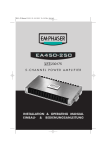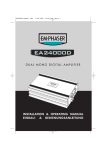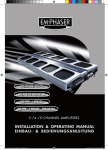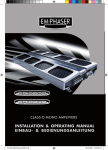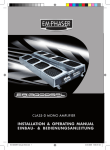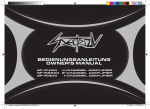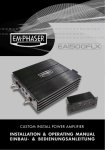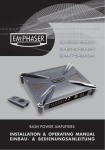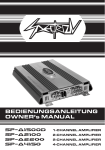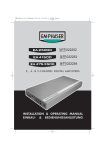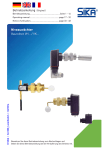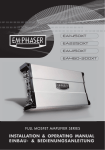Download EMPHASER EA1300 Specifications
Transcript
EA285
EA485
EA1300
2-CHANNEL AMPLIFIER
4-CHANNEL AMPLIFIER
1-CHANNEL MONO AMPLIFIER
INSTALLATION & OPERATION MANUAL
EINBAU- & BEDIENUNGSANLEITUNG
CONTENTS
1. KEY FEATURES
2. CONNECTIONS & CONTROLS
INHALT
5
1.HAUPTMERKMALE
6-11
2. ANSCHLÜSSE + BEDIENUNGSELEMENTE 17
18-23
2.1 INPUT + OUTPUTS EA285
6
2.1 EINGÄNGE + AUSGÄNGE EA285
18
2.2 TOP CONTROLS EA285
7
2.2 TOP CONTROL BEDIENELEMENTE EA285
19
2.1 INPUT + OUTPUTS EA485
8
2.1 EINGÄNGE + AUSGÄNGE EA485
20
2.2 TOP CONTROLS EA485
9
2.2 TOP CONTROL BEDIENELEMENTE EA485
21
2.1 INPUT + OUTPUTS EA1300
10
2.1 EINGÄNGE + AUSGÄNGE EA1300
22
2.2 TOP CONTROLS EA1300
11
2.2 TOP CONTROL BEDIENELEMENTE EA1300
23
3. AMPLIFIER MOUNTING
12
3. MONTAGE DES VERSTÄRKERS
4. WIRE ROUTING
13
4. VERKABELUNG / ELEKTRISCHER ANSCHLUSS25
4.1 MAIN POWER WIRES
13
4.1 HAUPT-STROMKABEL
25
4.2 RCA & REMOTE WIRES
13
4.2 CINCH- & REMOTE KABEL
25
4.3 LOUDSPEAKER WIRES
13
4.3 LAUTSPRECHERKABEL
25
5. CROSSOVER ADJUSTMENTS
14-15
24
5. EINSTELLUNG DER FREQUENZWEICHE26-27
5.1 SELECTING THE OPERATION MODE
14
5.1 WAHL DES BETRIEBSMODUS
26
5.2 HIGH PASS CROSSOVER FREQUENCY ADJUSTMENT
14
5.2 HOCHPASS TRENNFREQUENZ
26
5.3 LOW PASS CROSSOVER FREQUENCY ADJUSTMENT
14
5.3 TIEFPASS TRENNFREQUENZ
26
5.4 SUBSONIC / HIGH PASS CROSSOVER ADJUSTMENT
15
5.4 SUBSONIC / HOCHPASS TRENNFREQUENZ
27
5.5 PHASE ADJUSTMENT
15
5.5 EINGANGSEMPFINDLICHKEIT
27
5.6 INPUT GAIN ADJUSTMENT
15
5.6 INPUT GAIN EINSTELLUNG
27
6. MASTER / SLAVE CONNECTION
28
6. MASTER / SLAVE ANSCHLUSS-SCHEMA
28
7. TECHNICAL SPECIFICATIONS
29
7. TECHNISCHE SPEZIFIKATIONEN
29
8. WARRANTY CONDITIONS + LIMITATIONS
30
8. GARANTIE-BESTIMMUNGEN + EINSCHRÄNKUNGEN
30
9. WARRANTY SLIP 31
9.GARANTIE-KARTE
2
31
3
1. KEY FEATURES
Thank you for purchasing this EMPHASER amplifier!
To maximize the performance of this amplifier and your complete car audio system install,
we recommend that you acquaint yourself thoroughly with all technical features and controlling options of this EMPHASER amplifier. Please read this manual carefully, before
attempting the installation.
If, after reading this manual, you still have questions regarding functions or the installation
of the amplifier, we recommend that you consult your EMPHASER dealer.
4
•
•
•
•
•
•
•
•
•
•
•
•
•
•
1CH / 2CH / 4CH BJT Amp for 4/2 Ohms Stereo Operation
Mono Bridge Operation into 4 Ohms
Die Cast Aluminium Heatsink
Top Control Access of X-Over Controls
Adjustable 12dB/octave HP + LP X-Over
Adjustable 12dB/octave Subsonic X-Over
Phase Inversion Switch
Top Side Amp Status LED
High Level Input (4-Pin or 8-Pin)
Advanced Protection Circuit
Replaceable ATC Fusing
Moulded Power + Speaker Terminal
Remote Bass Control (only for EA1300)
Master / Slave Input + Output (only for EA1300)
5
2.
CONNECTIONS + TOP CONTROLS EA285
2.2 TOP CONTROLS
2.1 INPUTS + OUTPUTS
1 RCA INPUTS 1/2-CH
Low-level stereo RCA signal input 1/2-CH for connection to head-unit.
1
2 HIGH INPUT
Molex connector terminal to insert the High level adapter (4-Pin) that picks up the
amplified speaker signal from the head unit’s front output (if head unit does not
feature dedicated RCA line outs).
INPUT GAIN CONTROL 1/2-CH
Input gain potentiometer for channel 1/2-CH, to match the output voltage of the headunit to the amplifier’s input.
2
OPERATION MODE SWITCH 1/2-CH
Slide switch to select the operation mode of the X-over for section 1/2-CH of the
amplifier.
3
SPEAKER OUTPUT TERMINAL
Output terminal to connect the speakers to the amplifier in either stereo or bridged
mode. For bridge connection, use the terminals with fat polarity signs.
3
X-OVER FREQUENCY CONTROL 1/2-CH
Control potentiometer to adjust the highpass or lowpass filtering frequency point for
section 1/2-CH of the amplifier.
4
ATC FUSE HOLDER
Fuse holder for 1 x 25 A ATC fuse. Never deploy fuses of higher amperage rating.
5
“+12 V” POWER INPUT TERMINAL
Terminal to connect the amplifier to the positive +12 V pole of the car battery.
4
SUBSONIC HIGHPASS FREQUENCY CONTROL 1/2-CH
Control potentiometer to adjust the subsonic highpass filtering frequency point for
section 1/2-CH of the amplifier.
6
“REM” INPUT TERMINAL
Terminal to connect the amplifier to the automatic (remote) turn-on / turn-off lead of
the head unit.
5
PHASE SWITCH 1/2-CH
Switch to select normal or inverted phase for section 1/2-CH of the amplifier.
7
“GND” POWER INPUT TERMINAL
Terminal to connect the amplifier to the chassis ground or negative pole of the car
battery.
6
POWER LED
LED bar segment to show “operating” status of the amplifier by red illumination.
Protect state of amplifier is signaled by blue state.
1
2
3
1 2 3
EA285
EA285
INPUT
INPUT
INPUT
CH1
CH1
CH1
HIGH INPUT
HIGH INPUT
CH2
CH2
CH2
CH1
CH1
CH1
Ch1+ Ch2+
CH2
CH2
CH2
Ch1- Ch2-
HIGH INPUT
SPEAKER OUTPUT
GAIN
4
5 6 7
MIN
MAX
SUB
SONIC
15Hz
FUSE
FUSE
FUSE
25 A
12V
12V
EA285
25A
12V
REM
REM
REM
50Hz
X-OVER
PHASE
180°
0°
GND
GND
GND
POWER INPUT
4
6
MODE
LPF
HPF 50Hz 250Hz
FLAT
5
6
7
2.
2.2 TOP CONTROLS
CONNECTIONS + TOP CONTROLS EA485
2.1 INPUTS + OUTPUTS
1 RCA INPUTS 1/2-CH + 3/4-CH
Low-level stereo RCA signal input 1/2-CH and 3/4-CH, for connection to head-unit.
2 HIGH INPUT
Molex connector terminal to insert the High level adapter (8-Pin) that picks up the
amplified speaker signals from the head unit’s front and rear outputs (if head unit
does not feature dedicated RCA line outs).
3
SPEAKER OUTPUT TERMINAL
Output terminal to connect the speakers to the amplifier in either stereo or bridged
mode. For bridge connection, use the terminals with fat polarity signs.
4
ATC FUSE HOLDER
Fuse holder for 1 x 40 A ATC fuse. Never deploy fuses of higher amperage rating.
5
“+12 V” POWER INPUT TERMINAL
Terminal to connect the amplifier to the positive +12 V pole of the car battery.
6
“REM” INPUT TERMINAL
Terminal to connect the amplifier to the automatic (remote) turn-on / turn-off lead of
the head unit.
7
“GND” POWER INPUT TERMINAL
Terminal to connect the amplifier to the chassis ground or negative pole of the car
battery.
8
“FAN”
Internal fan to cool and safeguard amplifier electronics against overheating.
1
2
CH1
CH1
INPUT
INPUT
EA485
CH3
CH3
3
CH2
CH2
CH1
CH1
CH4
CH4
CH3
CH3
1
INPUT GAIN CONTROL 1/2-CH
Input gain potentiometer for channel 1/2-CH, to match the output voltage of the
head-unit to the amplifier’s input.
2
OPERATION MODE SWITCH 1/2-CH
Slide switch to select the operation mode of the X-over for section 1/2-CH of the
amplifier.
3
X-OVER FREQUENCY CONTROL 1/2-CH
Control potentiometer to adjust the highpass or lowpass filtering frequency point for
section 1/2-CH of the amplifier.
4
INPUT GAIN CONTROL 3/4-CH
Input gain potentiometer for channel 3/4-CH, to match the output voltage of the
head-unit to the amplifier’s input.
5
OPERATION MODE SWITCH 3/4-CH
Slide switch to select the operation mode of the X-over for section 3/4-CH of the
amplifier.
6
X-OVER FREQUENCY CONTROL 3/4-CH
Control potentiometer to adjust the highpass or lowpass filtering frequency point for
section 3/4-CH of the amplifier.
7
PHASE SWITCH 3/4-CH
Switch to select normal or inverted phase for section 3/4-CH of the amplifier.
8
SUBSONIC HIGHPASS FREQUENCY CONTROL 3/4-CH
Control potentiometer to adjust the subsonic highpass filtering frequency point for
section 3/4-CH of the amplifier.
9
POWER LED
LED bar segment to show “operating” status of the amplifier by red illumination.
Protect state of amplifier is signaled by blue state.
1 2 3
Ch1+ Ch2+ Ch3+ Ch4+
HIGH INPUT
Ch1- Ch2- Ch3- Ch4-
CH2
CH2
CH4
CH4
HIGH
HIGH INPUT
INPUT
GAIN
CH1/CH2
4
5 6 7
8
MIN
MAX
GAIN
MODE
X-OVER
LPF
HPF
FLAT
50Hz 250Hz
FLAT
LPF
HPF
X-OVER
PHASE
SUB SONIC
CH3/CH4
MIN
MAX
50Hz 250Hz 180°
0°
15Hz
50Hz
REM
40 A
FUSES
EA485
8
FUSES
REM
12V
25AX2
12V
GND
GND
POWER INPUT
4
5 6
7
8
9
9
2.
CONNECTIONS + TOP CONTROLS EA1300
2.1 INPUTS + OUTPUTS
1
2.2 TOP CONTROLS
CINCH MASTER / SLAVE IN-OUT
Master Slave RCA sockets to connect at least two EA1300 amps in Master / Slave
mode. Master / Slave mode allows to drive one amp with RCA input signal from the
head unit, and to daisy chain all further amps of the system.
To connect in Master / Slave mode, a mono RCA interconnect cable is required. See
connection drawing on page 28.
2
RCA INPUTS 1/2-CH
Low-level stereo RCA signal input 1/2-CH for connection to head-unit.
3
REMOTE CONTROL INPUT
Input terminal to connect the external bass level remote to the amplifier.
4
HIGH INPUT
Molex connector terminal to insert the High level adapter (4-Pin) that picks up the
amplified speaker signals from the head unit’s front and rear outputs (if head unit
does not feature dedicated RCA line outs).
5
SPEAKER OUTPUT TERMINAL
Output terminal to connect the speakers to the amplifier in either stereo or bridged
mode. For bridge connection, use the terminals with fat polarity signs.
6
ATC FUSE HOLDER
Fuse holder for 2 x 25 A ATC fuses. Never deploy fuses of higher amperage rating.
7
“+12 V” POWER INPUT TERMINAL
Terminal to connect the amplifier to the positive +12 V pole of the car battery.
8
“REM” INPUT TERMINAL
Terminal to connect the amplifier to the automatic (remote) turn-on / turn-off lead of
the head unit.
9
EA1300
“GND” POWER INPUT TERMINAL
Terminal to connect the amplifier to the chassis ground orHIGH
negative
pole of the car
INPUT
battery.
REM
1
CH1
IN
CH2
2 3 4
INPUT GAIN CONTROL CH1/CH2
Input gain potentiometer for channel CH1/CH2, to match the output voltage of the
head-unit to the amplifier’s input.
2
PHASE SWITCH CH1/CH2
Switch to select normal or inverted phase for section CH1/CH2 of the amplifier.
3 X-OVER FREQUENCY CONTROL CH1/CH2
Control potentiometer to adjust the lowpass filtering frequency point for section
CH1/CH2 of the amplifier.
4
SUBSONIC HIGHPASS FREQUENCY CONTROL
Control potentiometer to adjust the subsonic highpass filtering frequency point for
section CH1/CH2 of the amplifier.
5
POWER LED
LED bar segment to show “operating” status of the amplifier by red illumination.
Protect state of amplifier is signaled by blue state.
1 2 3
INPUT
MASTER/SLAVE
OUT
1
5
6
7 8 9
GAIN
MIN
OUT
OUT
CH1
CH1
FUSES
IN
IN
REM
REM
CH2
CH2
HIGH
HIGH INPUT
INPUT
12V
GND
15Hz
FUSES
FUSES
40Hz
250Hz
50Hz
SPEAKER OUTPUT
4
10
0°
25 A
25 A
INPUT
INPUT
MASTER/SLAVE
BRIDGE
Ch1+ Ch2+
HIGH
Ch1- INPUT
Ch2-
180°
LPF
SUB
SONIC
REM
EA1300
MAX
PHASE
REM
REM
12V
12V
GND
GND
5
11
2.3 SPEAKER IMPEDANCE & POWER WIRE INFO
It is recommended that you follow the optimum speaker / subwoofer impedance info suggested
below.
EA285 ➡ EA485 ➡ EA1300 ➡ 4/2 ohms stereo / 4 ohms mono bridged
4/2 ohms stereo / 4 ohms mono bridged
4/2 ohms mono / 4 ohms in Master / Slave mode
3. AMPLIFIER MOUNTING
ATTENTION! For your own safety, disconnect the negative battery terminal
(GND) or remove the main fuse in the positive power cable near the car battery,
before you start any wiring work!
Before you proceed to install this EMPHASER amplifier, it is recommended to map out the
complete system and the respective wiring required. Consider all additional electrical requirements and accessories, such as power cables, interconnect cables etc., to complete the install.
Please note that - because of possible interference problems with the existing car electrics and
electronics - especially the routing of the signal cables and the chassis ground connection will
have a profound impact on the trouble-free (noise free!) operation of the amplifier.
The mounting location should be carefully selected and in the interest of passive driver and
passenger safety, the amplifier must be securely mounted. Make sure that there is no wiring
harness, fuel tank etc. behind or below the mounting surface, that may be damaged by the drilling of the holes for the amplifier mounting screws. After installation, there should be a clearance
of at least 5 cm to all sides including the top of the amplifier heatsink. Make sure the unit is not
exposed to direct sunlight, humidity, water, oil or spill of other fluids that may enter the amplifier.
Once the location where the amplifier will be mounted is defined, use the unit as a template for
the marking of the mounting holes with pencil or felt-tip marker. The mounting holes should be
pilot-drilled, using a 2,5 mm or 3 mm drill bit. Bolt the amp down.
IMPORTANT! There must not be a direct contact of the amplifier heatsink, bottom panel or any
other metal part of the amplifier to the vehicle metal panel! Electrical ground-loops will cause
audible hum!
4. WIRE ROUTING
4.1 MAIN POWER WIRES
We recommend a minimum main power cable cross-section (5m total length) of 16 mm²,
for both the positive and the ground wires. Following these recommendations guarantees a
trouble-free operation of your amplifier, as well as full power output.
Run the positive main power cable („+12 V“) directly from the positive terminal of the car battery to the amplifier. For protection of your car audio system against electrical fire hazards,
resulting from a short-circuit of the main power cable to chassis ground a main fuse holder
must be inserted within the first 30 cm of the positive main power cable. The applicable fuse
value must be matched to the limitations of your main power cable AND the current draw of
the amplifier – therefore choose an appropriate fuse value.
Attach the ground cable to the amplifier. In most cases it will be best to keep the ground cable
(„-12 V“) as short as possible, i.e. to find a chassis contact very close to the amplifier. The
ground power wire must have the same cross-section as the positive power cable. The contact
point where the ground wire is attached to, must be solid and clean, i.e. free from rust or paint!
Tighten both power input terminals of the amplifier, and double check for perfect fit of both
main cable leads!
4.2 RCA & REMOTE WIRES
For best interference free transmission of the music signal, use double or triple shielded RCA
interconnects only. Twisted pair Interconnects offer excellent noise rejection as well. Route the
RCA interconnects away from potential sources of Interference, such as engine computers,
gas pumps, etc.
Carefully run the audio signal interconnects, the remote wire and – if applicable - the cable
of the low pass level remote control (EA1300 only) from the head unit or dashboard to the
amplifier. As mentioned before, the audio signal cables should always be routed completely
separate from the power cables. Connect the remote (turn on/turn off) lead to the respective
input terminal of the amplifier and to the remote output of your head-unit. Now you can connect the RCA interconnects to the respective outputs of your head-unit and to the inputs of the
amplifier. Pay attention to connect the stereo interconnects correspondingly, left is 1CH, right
is always 2CH a.s.o.
4.3 LOUDSPEAKER WIRES
For longer distances to the speakers, it is best to use 1.5 mm² or 2.5 mm² speaker cables to
avoid a loss of power or risk degradation of the signal quality.
Once the speaker cables have been routed, turn loose the screws of the speaker terminal
binding posts and – after inserting the stripped and bare speaker cable ends – re-tighten the
screws. Maintain correct polarity („+“ to „+“; „-„ to „-„).
Close the electrical circuit by attaching the ground wire to the battery and switch on your head
unit. The status bar below the EMPHASER logo should turn on. If the status bar does not illuminate, your installation is wrong! Immediately turn off your head-unit and carefully re-check
all installation and wiring steps!
12
13
5.4 SUBSONIC / HIGH PASS CROSSOVER FREQUENCY ADJUSTMENT
5. CROSSOVER ADJUSTMENTS
For the amplifier to perform best with your speakers, the electronic crossover controls must
be set and adjusted accordingly. Since all controls can be accessed directly from the top side
of the amp, this should not prove too difficult.
5.1 SELECTING THE OPERATION MODE
You must select and set the appropriate operation mode before you can proceed to to adjust
crossover frequency points. This operation mode depends on the speaker system connected
to the respective amplifier channels.
■ Select HIGHPASS, if the speaker system is a component-, coaxial- or triaxial- type.
■ Select LOWPASS in case of a subwoofer system.
■ Select FLAT, if your speaker system will handle a full range signal without electrical or
mechanical overload.
5.2 HIGH PASS CROSSOVER FREQUENCY ADJUSTMENT
For satellite speaker systems, select the “HPF” mode, to cut off the bass content in the music
signal.
Highpass filtering will take away unnecessary mechanical and electrical ‘strain’ from the connected coaxial or component speaker systems. Depending on cone surface, voice-coil diameter
and the power handling of the speakers, the following recommendations can be issued:
Front Door Satellite Speaker System („HPF” MODE)
13 cm 2-way Component System
16 cm 2- or 3-way Component System
HP CrossOver Frequency
Rear Satellite Speaker System („HPF” MODE)
13 cm 2-way Coaxial or Component System
16 cm 2-way Coaxial or Component System
6 x 9” or 7 x 10” Triaxial Speaker System
HP CrossOver Frequency
80 - 110 Hz
50 - 80 Hz
100 - 120 Hz*
100 - 120 Hz*
100 - 120 Hz*
* When a subwoofer is part of the audio system install.
5.3 LOW PASS CROSSOVER FREQUENCY ADJUSTMENT
Select “LPF”, to activate the lowpass filter of the integrated electronic crossover.
The LOWPASS cut-off frequency setting depends on the woofer system and each vehicle is
different! As a rule of thumb, settings in between 60 to 90 Hz will usually give solid results. The
woofer lowpass frequency point is mostly a matter of taste, and must therefore be ‘played by ear’.
14
Now proceed to adjust the subsonic highpass frequency. This subsonic crossover frequency
point depends on the size and the power handling of the installed subwoofer system. The
higher the subsonic crossover frequency is set, the better or higher mechanical power handling
will result. The trade-off is reduced low end extension! The subsonic highpass cannot be
bypassed. But you can set the potentiometer to a value of 15 Hz to make subsonic filtering
completely inaudible.
5.5 PHASE ADJUSTMENT
Depending on the speaker systems installed and the subwoofer enclosure type, it may be
necessary to invert the phase of the channel(s) that drive the subwoofer. Do so by trying both
slide switch positions of the Phase control switch. In phase response is what you want - out of
phase will cause a full or partially cancellation of bass signals (and the system will sound "thin").
5.6 INPUT GAIN ADJUSTMENT
To reach a maximum in dynamic response from each individual head-unit/amplifier/speaker
combination, it is important to set the respective input sensitivity controls („GAIN“) of all channel pairs correctly.
Before you start, you MUST set all tone controls (Bass, Mid, Treble, Loudness etc.) and the
fader on the head unit to their neutral or center positions.
Now turn all input gain controls of the installed amplifiers anti-clockwise to their minimum positions and start with the channel pair, that drives the subwoofer system.
SUBWOOFER CHANNEL(S)
Set the volume control of your head-unit to approximately ¾ of full volume, while playing a
dynamic piece of music. Slowly increase the input gain control of the channel pair driving the
subwoofer(s), by turning the GAIN control clockwise. Increase clockwise until the bass starts
to distort. Reduce the main volume level of your head-unit to a medium listening level. Proceed
with further channels, if applicable.
SATELLITE CHANNELS
Slowly increase the input gain control of the channel pair driving the satellite system, by turning the GAIN control clockwise. Increase clockwise until you reach a good tonal balance with
a slight emphasis of the bass range. Repeat for all further channels.
FINE TUNING OF ALL CROSSOVER FREQUNCY POINT SETTINGS
Finally you can attempt to fine-tune the HP, BP and/or the LP crossover frequencies on your
amplifier setup, to reach the maximum tonal balance and channel integration of all loudspeakers connected to your car audio system.
15
1. HAUPTMERKMALE
Wir danken Ihnen für den Kauf dieser EMPHASER Endstufe.
Damit Sie die Wiedergabequalität und die Leistungsfähigkeit dieses Verstärkers voll ausschöpfen können, bitten wir Sie, sich eingehend mit den Möglichkeiten und technischen Features
dieses Verstärkers vertraut zu machen. Lesen Sie deshalb die nachfolgenden Abschnitte
sorgfältig durch und bewahren Sie diese Bedienungsanleitung auf.
Falls Sie im Anschluss weitergehende Fragen zu den Funktionen oder dem Anschluss dieser
Endstufe haben, kontaktieren Sie Ihren EMPHASER Händler.
16
•
•
•
•
•
•
•
•
•
•
•
•
•
2CH / 4CH oder 1CH BJT Endstufe für 4/2 Ohm Lautsprecherimpedanz
Gehäuse aus Druckguss Aluminium
Aktivweiche mit Zugang auf die Regler von oben
Einstellbare 12dB/Oktav HP + TP Frequenzweiche
Einstellbarer Subsonic Hochpass
Phasenumschalter
Anzeige vom Beriebsstatus oben auf dem Gehäuse
High Level Input (4-Pin oder 8-Pin)
Clevere Schutzschaltung
ATC Sicherung(en)
Druckguss Anschlussterminals
Basspegel Fernbedienung (nur für EA1300)
Master / Slave In-Out (nur für EA1300)
17
2.
ANSCHLÜSSE + BEDIENUNGSELEMENTE EA285
2.2 TOP CONTROL BEDIENELEMENTE
2.1 EINGÄNGE + AUSGÄNGE
1 CINCH INPUTS 1/2-CH
Cinch Eingangsbuchsen 1/2-CH für den Anschluss der Cinch Ausgänge des
Steuergerätes.
2 HIGH INPUT
Molex Steckerterminal für den Anschluss des Adapters zum Abgriff der
Lautsprecherausgänge des Headunits (wenn das Steuergerät nicht über Cinch
Line-Outs verfügt).
3
LAUTSPRECHER AUSGANGS-TERMINAL
Lautsprecheranschlussterminal für den Anschluss von Lautsprechern, stereo oder
gebrückt.
4
ATC SICHERUNGSHALTER
Zur internen Absicherung der Endstufe. Ausgelegt für eine 25 A ATC Sicherung.
Verwenden Sie keine höheren Werte wie auf der Endstufe angegeben.
5
“+12 V” POWER INPUT TERMINAL
16 mm² Eingangsterminal für den Anschluss an den Pluspol der Fahrzeugbatterie.
6
“REM” INPUT TERMINAL
Eingangsterminal für den Anschluss des Remote-Kabels über den Amp- oder
Antenna-Remote Ausgang des Steuergerätes.
7
“GND” POWER INPUT TERMINAL
16 mm² Eingangsterminal für den Anschluss an die Chassis-Masse des Kfz’s oder
den Minuspol der Fahrzeugbatterie.
1
2
INPUT
INPUT
INPUT
3
1
REGLER EINGANGSEMPFINDLICHKEIT 1/2-CH
Eingangsempfindlichkeitsregler „GAIN“ der Kanäle 1/2-CH, für die Anpassung an die Ausgangsspannung des Steuergerätes.
2
SCHALTER FÜR BETRIEBART DER KANÄLE 1/2-CH
Schiebeschalter „MODE“ für die Festlegung der Arbeitsweise der integrierten
elektronischen Frequenzweiche der Kanäle 1/2-CH.
3
REGLER TRENNFREQUENZ 1/2-CH
Regler „X-OVER“ zum Einstellen der Hochpass oder Tiefpass Trennfrequenz an der integrierten elektronischen Frequenzweiche der Kanäle 1/2-CH.
4
REGLER SUBSONIC HOCHPASS TRENNFREQUENZ 1/2-CH
Regler „SUBSONIC“ zum Einstellen der Hochpass Trennfrequenz von 15 Hz bis
50 Hz an der integrierten elektronischen Frequenzweiche für die Kanäle 1/2-CH.
5
SCHALTER FÜR PHASE KANÄLE 1/2-CH
Schiebeschalter „PHASE“ für die Festlegung der akustischen Phasenlage des
Ausgangssignals für die Kanäle 1/2-CH.
6
POWER LED
LED Segment, welche durch rotes leuchten den normalen Betriebszustand der
Endstufe im eingeschalteten Zustand signalisiert. Im Protect Modus leuchtet dieses
Segment blau.
1 2 3
EA285
EA285
CH1
CH1
CH1
HIGH INPUT
HIGH INPUT
CH2
CH2
CH2
CH1
CH1
CH1
Ch1+ Ch2+
CH2
CH2
CH2
Ch1- Ch2-
HIGH INPUT
SPEAKER OUTPUT
GAIN
4
5 6 7
MIN
MAX
SUB
SONIC
15Hz
FUSE
FUSE
FUSE
25 A
12V
12V
EA285
25A
12V
REM
REM
REM
50Hz
X-OVER
PHASE
180°
0°
GND
GND
GND
POWER INPUT
4
18
MODE
LPF
HPF 50Hz 250Hz
FLAT
5
6
19
2.
ANSCHLÜSSE + BEDIENUNGSELEMENTE EA485
2.1 EINGÄNGE + AUSGÄNGE
1 CINCH INPUTS 1/2-CH + 3/4-CH
Cinch Eingangsbuchsen 1/2-CH und 3/4-CH für den Anschluss der Cinch Ausgänge
des Steuergerätes.
2 HIGH INPUT
Molex Steckerterminal für den Anschluss des Adapters zum Abgriff der
Lautsprecherausgänge des Headunits (wenn das Steuergerät nicht über Cinch
Line-Outs verfügt).
2.2 TOP CONTROL BEDIENELEMENTE
1
REGLER EINGANGSEMPFINDLICHKEIT 1/2-CH
Eingangsempfindlichkeitsregler „GAIN“ der Kanäle 1/2-CH, für die Anpassung an
die Ausgangsspannung des Steuergerätes.
2
SCHALTER FÜR BETRIEBART DER KANÄLE 1/2-CH
Schiebeschalter „MODE“ für die Festlegung der Arbeitsweise der integrierten
elektronischen Frequenzweiche der Kanäle 1/2-CH.
3
REGLER TRENNFREQUENZ 1/2-CH
Regler „X-OVER“ zum Einstellen der Hochpass oder Tiefpass Trennfrequenz an der
integrierten elektronischen Frequenzweiche der Kanäle 1/2-CH.
3
LAUTSPRECHER AUSGANGS-TERMINAL
Lautsprecheranschlussterminal für den Anschluss von Front- und Rear
Lautsprechern, stereo oder gebrückt.
4
4
ATC SICHERUNGSHALTER
Zur internen Absicherung der Endstufe. Ausgelegt für eine 40 A ATC Sicherung.
Verwenden Sie keine höheren Werte wie auf der Endstufe angegeben.
REGLER EINGANGSEMPFINDLICHKEIT 3/4-CH
Eingangsempfindlichkeitsregler „GAIN“ der Kanäle 3/4-CH, für die Anpassung an
die Ausgangsspannung des Steuergerätes.
5
5
“+12 V” POWER INPUT TERMINAL
16 mm² Eingangsterminal für den Anschluss an den Pluspol der Fahrzeugbatterie.
SCHALTER FÜR BETRIEBART DER KANÄLE 3/4-CH
Schiebeschalter „MODE“ für die Festlegung der Arbeitsweise der integrierten
elektronischen Frequenzweiche der Kanäle 3/4-CH.
6
“REM” INPUT TERMINAL
Eingangsterminal für den Anschluss des Remote-Kabels über den Amp- oder
Antenna-Remote Ausgang des Steuergerätes.
6
REGLER TRENNFREQUENZ 3/4-CH
Regler „X-OVER“ zum Einstellen der Hochpass oder Tiefpass Trennfrequenz an der
integrierten elektronischen Frequenzweiche der Kanäle 3/4-CH.
7
“GND” POWER INPUT TERMINAL
16 mm² Eingangsterminal für den Anschluss an die Chassis-Masse des Kfz’s, oder
den Minuspol der Fahrzeugbatterie.
7
SCHALTER FÜR PHASE KANÄLE 3/4-CH
Schiebeschalter „PHASE“ für die Festlegung der akustischen Phasenlage des
Ausgangssignals für die Kanäle 3/4-CH.
8
REGLER SUBSONIC HOCHPASS TRENNFREQUENZ 3/4-CH
Regler „SUBSONIC“ zum Einstellen der Hochpass Trennfrequenz von 15 Hz bis 50
Hz an der integrierten elektronischen Frequenzweiche für die Kanäle 3/4-CH.
9
POWER LED
LED Segment, welche durch rotes leuchten den normalen Betriebszustand der
Endstufe im eingeschalteten Zustand signalisiert. Im Protect Modus leuchtet dieses
Segment blau.
8
“FAN”
Integrierter Lüfter, welcher die Leistungselektronik gegen Überhitzung schützt.
1
3
2
CH3
CH1
CH3
CH1
CH3
CH1INPUT
INPUT
INPUT
EA485
EA485
CH2
CH2
CH2
CH1
CH1
CH1
CH4
CH4
CH4
CH3
CH3
CH3
1 2 3
HIGH
Ch1+
Ch2+INPUT
Ch3+ Ch4+
HIGH INPUT
Ch1- Ch2- Ch3- Ch4-
CH2
CH2
CH2
4
CH4
CH4
CH4
HIGH
HIGH INPUT
INPUT
5 6 7
GAIN
8
CH1/CH2
MIN
MAX
GAIN
MODE
X-OVER
LPF
HPF
FLAT
50Hz 250Hz
FLAT
LPF
HPF
X-OVER
PHASE
SUB SONIC
CH3/CH4
40 A
FUSES
FUSES
EA485
20
REM
FUSES
REM
12V
12V
25AX2
MIN
REM
GND
GND
12V
MAX
50Hz 250Hz 180°
0°
15Hz
50Hz
GND
POWER INPUT
4
5 6
7
8
9
21
2.
ANSCHLÜSSE + BEDIENUNGSELEMENTE EA1300
2.1 EINGÄNGE + AUSGÄNGE
1
2
2.2 TOP CONTROL BEDIENELEMENTE
CINCH MASTER / SLAVE IN-OUT
Master / Slave Cinchbuchsen, um mindestens zwei EA1300 mit nur einem
Eingangssignal vom Steuergerät anzusteuern. Master ist die Endstufe, welche das
Eingangssignal auf Cinch Inputs 1/2-CH vom Steuergerät erhält. Für den Betrieb
im Master / Slave Modus benötigt man ein mono Cinchkabel. Beachten Sie die
Anschlusszeichnung für Master / Slave Betrieb auf Seite 28.
CINCH INPUTS 1/2-CH
Cinch Eingangsbuchsen 1/2-CH für den Anschluss der Cinch Ausgänge des
Steuergerätes.
3 REMOTE CONTROL INPUT
Eingangsbuchse zum Anschluss der Basspegel Fernbedienung.
4
HIGH INPUT
Molex Steckerterminal für den Anschluss des Adapters zum Abgriff der
Lautsprecherausgänge des Headunits (wenn das Steuergerät nicht über Cinch
Line-Outs verfügt).
5 LAUTSPRECHER AUSGANGS-TERMINAL
Lautsprecheranschlussterminal für den Anschluss von Lautsprechern, stereo oder gebrückt.
ATC SICHERUNGSHALTER
Zur internen Absicherung der Endstufe. Ausgelegt für zwei 25 A ATC Sicherungen.
Verwenden Sie keine höheren Werte wie auf der Endstufe angegeben.
7
“+12 V” POWER INPUT TERMINAL
16 mm² Eingangsterminal für den Anschluss an den Pluspol der Fahrzeugbatterie.
8
“REM” INPUT TERMINAL
Eingangsterminal für den Anschluss des Remote-Kabels über den Amp- oder
Antenna-Remote Ausgang des Steuergerätes.
9
OUT
CH1
EA1300
“GND” POWER INPUT TERMINAL
16 mm² Eingangsterminal für den Anschluss an die Chassis-Masse
des Kfz’s oder
HIGH INPUT
den Minuspol der Fahrzeugbatterie.
INPUT
MASTER/SLAVE
6
IN
1
2 3 4
REGLER EINGANGSEMPFINDLICHKEIT CH1/CH2
Eingangsempfindlichkeitsregler der Kanäle CH1/CH2, für die Anpassung an die
Ausgangsspannung des Steuergerätes.
2
SCHALTER FÜR PHASE CH1/CH2
Schiebeschalter „PHASE“ für die Festlegung der akustischen Phasenlage des
Ausgangssignals für die Kanäle CH1/CH2.
3
REGLER TIEFPASS TRENNFREQUENZ CH1/CH2
Regler zum Einstellen der Tiefpass-Trennfrequenz an der integrierten
elektronischen Frequenzweiche der Kanäle CH1/CH2.
4
REGLER SUBSONIC HOCHPASS TRENNFREQUENZ
Regler „SUBSONIC“ zum Einstellen der Hochpass Trennfrequenz von 15 Hz bis
50 Hz an der integrierten elektronischen Frequenzweiche für die Kanäle CH1/CH2.
5
POWER LED
LED Segment, welche durch rotes leuchten den normalen Betriebszustand der
Endstufe im eingeschalteten Zustand signalisiert. Im Protect Modus leuchtet dieses
Segment blau.
1 2 3
REM
CH2
5
1
6
7 8 9
GAIN
MIN
MAX
PHASE
180°
0°
LPF
40Hz
250Hz
SUB
SONIC
15Hz
OUT
OUT
CH1
CH1
FUSES
22
CH2
CH2
REM
REM
HIGH
HIGH INPUT
INPUT
SPEAKER OUTPUT
12V
GND
25 A
HIGH
Ch1-INPUT
Ch2-
25 A
INPUT
INPUT
BRIDGE
MASTER/SLAVE
Ch1+ Ch2+
IN
IN
50Hz
REM
EA1300
4
5
23
2.3 LAUTSPRECHER IMPEDANZ & KABELINFOS
Die möglichen Abschlussimpedanzen Ihres Verstärker Modells entnehmen Sie den folgenden
Angaben.
EA285 ➡ EA485 ➡ EA1300 ➡ 4/2 Ohm stereo / 4 Ohm mono gebrückt
4/2 Ohm stereo / 4 Ohm mono gebrückt
4/2 Ohm mono / 4 Ohm für Master / Slave
3. MONTAGE DES VERSTÄRKERS
ACHTUNG! Entfernen Sie zu Ihrer eigenen Sicherheit erst das Massekabel von der
Batterie! Bei allen nachfolgend beschriebenen Installationsschritten muss der Stromkreis
des Kraftfahrzeugs unterbrochen sein! Erst nach Abschluss aller Installationsarbeiten wird
über das Massekabel der Stromkreis wieder geschlossen.
Bevor Sie mit der Montage dieses Verstärkers beginnen: Berücksichtigen Sie vorab die Kabelverläufe und den Installationsort des Car-Amps.
Der Verstärker sollte im Interesse der Sicherheit bei einem Unfall möglichst gut und solide
montiert werden. Die Endstufe sollte auf keinen Fall „unzugänglich verbaut“ werden, wegen
der schlechten Kühlung und auch den abschliessend erfolgenden Einstellarbeiten.
Als Montageort eignet sich z.B. ein Platz im Kofferraum oder an einem Seitenteil, bzw jeder
andere Ort, der eine saubere Installation ermöglicht.
Vermeiden Sie Montageorte mit „unbekanntem Hintergrund“. Es könnten sich ein Benzintank,
hydraulische Bremsleitungen, Kabelbäume etc. dahinter verbergen! Achten Sie auch auf einen
trockenen, gegen mechanische Einwirkungen geschützten Installationsort.
Halten Sie den Verstärker an den gewünschten Ort und markieren Sie mit einem geeigneten
Filzstift die Bohrposition der Befestigungslöcher.
Mit der gebotenen Vorsicht bohren Sie nun die angezeichneten Löcher mit einem 2,5 oder
3 mm Bohrer.
ACHTUNG: Die Endstufe darf niemals direkt auf die Fahrzeugmasse des Kfz’s geschraubt
werden da eine Masse-Brummschleife resultiert! Legen Sie nun den Verstärker auf die vorgebohrten Löcher und schrauben Sie ihn gut fest.
4. VERKABELUNG / ELEKTRISCHER ANSCHLUSS
4.1 HAUPT-STROMKABEL
Wir empfehlen einen minimalen Kabelquerschnitt (bei einer Länge von 5 m) von 16 mm² für
das +12 V und das Massekabel. Diese Empfehlung garantieren eine problemlose Funktion
des Verstärkers, sowie volle Leistungsabgabe ohne übermässige Erwärmung.
Verlegen Sie das Pluskabel direkt von der Batterie zum Verstärker.
Innerhalb der ersten 30 cm nach dem Pluspolklemmenabgriff muss eine Hauptsicherung
angebracht werden (Absicherung des Pluskabels gegen Kurzschluss auf Fahrzeug-Masse
und dadurch resultierendem Kabelbrand!). Verwenden Sie ein dem Stromkabelquerschnitt
entsprechenden Sicherungswert.
Schliessen Sie das Masse-Powerkabel am Verstärker und an einem geeigneten Massepunkt
im Fahrzeug an. Versuchen Sie das Massekabel so kurz wie möglich zu halten. Es sollte den
selben Querschnitt wie das positive Powerkabel besitzen. Achten Sie beim Massepunkt auf
eine perfekt gesäuberte blanke Metalloberfläche im Fahrzeug (schlechte Massepunkte sind
sehr oft die Ursache für Störungen).
4.2 CINCH- & REMOTE KABEL
Verwenden Sie für beste Einstörfestigkeit am besten doppelt oder dreifach abgeschirmte Kabel, oder sogenannte „Twisted Pair“ Typen. Die signalführenden Cinchkabel sollten soweit als
möglich von allen potentiellen „elektrischen Störsendern“ wie Bordcomputer, Benzinpumpe,
Black Boxes, etc. verlegt werden.
Verlegen Sie das oder die Cinchkabel, das Fernbedienungskabel für die Pegel-Regelung (nur
EA1300) von den Kanälen die den Subwoofer treiben und das Remote-Kabel vom Steuergerät
zur Endstufe.
Diese Kabel sollten unbedingt räumlich getrennt von der Stromzuführung des Verstärkers
eingezogen werden. Schliessen Sie das Remote-Kabel an das mit „REM“ bezeichnete Terminal an der Endstufe und an das mit Antenna-Rem. oder Amplifier-Rem. bezeichnete Kabel
Ihres Steuergerätes an.
Anschliessend stecken Sie die Cinchkabel in die Cinchbuchsen am Verstärker an. Beachten
Sie hierbei die Seitenkennung, d.h. 1-CH ist links, 2-CH ist rechts, etc!
Nun wird – falls erwünscht – noch die Fernbedienung (nur EA1300) in Griffnähe angebracht
und der Stecker vom Kabel in die Buchse am Verstärker eingesteckt.
4.3 LAUTSPRECHERKABEL
Verwenden Sie qualitativ gutes Lautsprecherkabel mit einem minimalen Querschnitt von
1.5mm² bis 2.5 mm². Bei größeren Längen um 5 m können Kabelquerschnitte bis zu 4.0 mm²
durchaus Sinn machen.
Schliessen Sie nun die Lautsprecherkabel an. Entfernen Sie ca. 6-8 mm der Isolierung des
LS-Kabels und beachten Sie die richtige Polung der Lautsprecherkabel am Terminal ("+" auf
"+", "-" auf "-"). Ziehen Sie die LS-Schraubklemmen satt an.
Schliessen Sie den Stromkreis zum Verstärker durch Remontage der Massepolklemme an der
Batterie. Ihr Verstärker sollte beim Einschalten des Steuergerätes durch das Aufleuchten der
beleuchteten Leiste unter dem EMPHASER Logo Betriebsbereitschaft anzeigen. Leuchtet die
Leiste nicht, ist Ihre Installation fehlerhaft. Gehen Sie die gesamten Installationsanweisungen
und die Verkabelung nochmals genau durch.
24
25
5.4 SUBSONIC HOCHPASS TRENNFREQUENZ
5. EINSTELLUNG DER FREQUENZWEICHE
Damit der Verstärker die angeschlossenen Lautsprechersysteme optimal ansteuern kann,
müssen Sie die Einstellungen an der Frequenzweiche vornehmen.
5.1 WAHL DES BETRIEBSMODUS
In Abhängigkeit der im Fahrzeug verbauten Lautsprechersysteme müssen Sie jedes
Kanalpaar über den "MODE" Betriebswahlschalter konfigurieren. Jedes Kanalpaar ermöglicht die Wahl von Hochpass und Tiefpass Betrieb der nachfolgenden Verstärkerkanäle
(EA1300 nur Tiefpass).
Die Hochpass oder Tiefpass Funktion teilt den eingesetzten Lautsprechersystemen nur
den Frequenzbereich zu, den der Lautsprecher verarbeiten kann. Beachten Sie folgende
Empfehlungen:
■
■
■
Wählen Sie HIGHPASS (“HPF”), wenn der angeschlossene Lautsprecher ein Koax-, Triax- oder Komponenten Lautsprecher ist.
Wählen Sie TIEFPASS (“LPF”), wenn der angeschlossene Lautsprecher ein Subwoofer System ist.
Wählen Sie FLAT, wenn der angeschlossene Lautsprecher den gesamten Frequenzbereich ohne Filterung verarbeiten kann.
Um den angeschlossenen Subwoofer von unnötiger Hubarbeit im subsonischen Bassbereich zu schützen, ist ein weiterer Regler genannt "Subsonic" vorhanden. Das
„Subsonicfilter“ schneidet alle Frequenzen unter dem eingestellten Wert mit 12dB/Okt. ab
und filtert die sehr tiefen (unhörbaren) Frequenzanteile im Programmaterial heraus, die
der angeschlossene Subwoofer entweder nicht wiedergeben kann, oder die ihn bei hohen
Ausgangspegeln zu extremen Auslenkungen treiben würde. Sie können das Subsonic
Potentiometer auf 15 Hz einstellen, womit es keinen Einfluss mehr auf den hörbaren
Bassbereich hat.
5.5 EINGANGSEMPFINDLICHKEIT
Die korrekte Eingangsempfindlichkeitseinstellung ist wichtig für die Ausnutzung des optimalen Dynamikspielraumes Ihrer Steuergerät / Verstärker / Lautsprecherkombination. Die
Empfindlichkeitseinstellung beeinflusst das Grundrauschen ebenso wie die verzerrungsfrei
erzielbare Maximallautstärke.
Bevor Sie mit der Anpassung der Eingangsempfindlichkeiten anfangen müssen zuallererst
alle Klangregler, sowie auch der Fader/Balance in die Mittel (Neutral) Position gebracht
werden. Deaktivieren Sie auch die Loudness Funktion.
5.2 HOCHPASS TRENNFREQUENZ
Mit der Einstellung der Trennfrequenz des Hochpasses („HPF“) soll eine elektrische
und mechanische Entlastung der verwendeten Koax- oder Komponentensysteme erfolgen. Je nach der vorhandenen Membranfläche und Nennbelastbarkeit der verwendeten
(Satelliten)-Systeme wird eine Trennfrequenz um 50 bis 150 Hz die besten Resultate
zeigen.
Komponentensystem Front („HPF“ aktiviert)
13 cm 2-Weg Komponentensystem
16 cm 2- oder 3-Weg Komponentensystem
HP Trennfrequenz
80 – 110 Hz
50 − 80 Hz
Kompo- oder Koaxsystem im Heckbereich („HPF“ aktiviert)
13 cm 2-Weg Koax- oder Komponentensystem
16 cm 2-Weg Koax- oder Komponentensystem
6 x 9“ oder 7 x 10“ Triaxialsystem
HP Trennfrequenz
100 − 120 Hz*
100 − 120 Hz*
100 − 120 Hz*
*Wenn ein Subwoofer Teil des Anlagenkonzeptes ist.
5.3 TIEFPASS TRENNFREQUENZ
Stellen Sie den MODE Betriebswahlschalter auf „LPF“. Die einzustellende Trennfrequenz
des Tiefpasses (LPF) sollte zwischen 60 bis 90 Hz liegen. Diese Einstellung erfolgt
rein gehörmässig und hängt von vielen Faktoren wie dem Subwoofer-System und dem
Fahrzeug selber ab.
26
5.6 INPUT GAIN EINSTELLUNG
SUBWOOFER
Falls sich ein Subwoofer im Anlagenkonzept befindet, muss der Eingangs-GAIN als
erster eingestellt werden. Drehen Sie den Input GAIN Regler an der Endstufe im
Gegenuhrzeigersinn auf die Minimumposition.
Stellen Sie den Lautstärkeregler Ihres Steuergerätes auf ca. ¾ der Maximallautstärke.
Drehen Sie nun den GAIN Regler vom Subwoofer Kanalpaar langsam im Uhrzeigersinn
auf, bis Sie die Verzerrungsgrenze im Bassbereich erreichen. Dann drehen Sie die
Lautstärke vom Steuergerät auf ca. halb zurück und nehmen Sie dann die Einstellung von
weiteren Kanalpaaren vor.
LAUTSPRECHERSYSTEME
Drehen Sie den GAIN Regler vom Kanalpaar der Frontsysteme langsam auf. „Dosieren“
Sie die Lautstärke des vorderen Lautsprechersystems so hinzu, dass sich ein ausgewogener basskräftiger Klang einstellt. Fahren Sie mit weiteren Kanalpaaren fort, falls im
Systemkonzept vorhanden.
Wenn die Input-Gain Einstellung an allen vorhandenen Kanalpaaren erfolgt ist, empfiehlt
es sich auch, die Trennfrequenzen nochmals fein einzustellen.
27
6. MASTER / SLAVE CONNECTION / ANSCHLUSS-SCHEMA
7. TECHNICAL SPECIFICATIONS / TECHNISCHE SPEZIFIKATIONEN
HEAD UNIT
AMP 1: MASTER
OUT
REM
CH2
EA1300
HIGH INPUT
INPUT
HIGH INPUT
IN
CH1
MASTER/SLAVE
RCA
AMP 2: SLAVE
EA1300
INPUT
REM
CH1
MASTER/SLAVE
OUT
IN
Woofer
REM
CH2
REM
FUSES
GAIN
MIN
MAX
PHASE
180°
0°
12V
LPF
40Hz
250Hz
REM
GND
FUSES
12V
GND
4 Ohms min.
Load
Impedance
Model
Number of Channels
EA285
2
EA485
EA1300
4 1
Rated Power Output (RMS)
At 4 Ohms / 13.8V (THD<=0.1%)
85 W x 2
85 W x 4 230 W x 1
Rated Power Output (RMS)
At 2 Ohms / 13.8V (THD<=0.1%)
110 W x 2
110 W x 4 360 W x 1
Rated Power Output (RMS)
At 4 Ohms / 13.8V (THD<=0.1%)
250 W x 1
250 W x 2 N.A.
Damping Factor
4 Ohms/100Hz
> 200
> 200 > 200
Signal-to-Noise Ratio
(All channels)
> 93 dB
> 93 dB > 93 dB
Frequency Response
(x-over set to FULL) 15 Hz – 30 kHz
15 Hz – 30 kHz 15 Hz – 250 Hz
Input Sensitivity
0.2 V – 7.0 V
0.2 V – 7.0 V
0.2 V – 7.0 V
Integrated X-Over
Slope Rates HPF / LPF
12 dB/octave
12 dB/octave
12dB/octave
Cross-Over Frequency
High Pass
Low Pass
Subsonic
50 – 250 Hz
50 – 250 Hz
15 – 50 Hz
50 – 250 Hz N.A.
50 – 250 Hz 40 – 250 Hz
15 – 50 Hz 15 – 50 Hz
Fuses
1 x 25 A
1 x 40 A
Dimensions (W x H x D) mm 250 x 60 x 120 360 x 60 x 120 300 x 60 x 120
SUB
SONIC
15Hz
50Hz
In Master/Slave mode, only the Master
amp top controls are functional.
GAIN
PHASE
LPF
In Master/Slave Modus sind nur die Top
Controls des Master Amps funktionell.
MIN
MAX
SUB
SONIC
15Hz
28
50Hz
180°
0°
40Hz
2 x 25 A
250Hz
29
8. WARRANTY CONDITIONS + LIMITATIONS
Dear customer
Please read the warranty specifications below carefully.
Should your EMPHASER amplifier require warranty service, please return it to the retailer from
whom it was purchased or the distributor in your country. Do not send any product to EMPHASER
Inc. U.S.A. Should you have difficulty in finding an authorized EMPHASER service center, details
are available from your local distributor.
This EMPHASER amplifier is fully warranted against defective materials or workmanship for a
period of two years from date of purchase at retail to the original buyer. Warranty work will not be
carried out unless this warranty certificate is presented fully completed with serial number, purchaser's address, purchasing date and dealer stamp together with the original sales slip and either
an authorized dealer's confirmation of installation or authorized dealer's installation approval!
This warranty does not cover any damage due to:
1. Unauthorized or unapproved installation, incorrect audio or mains connection(s).
2. Defects caused by exposure of the amplifier to humidity, water and organic fluids, prolonged
exposure to sun rays or excessive dirt or dust.
3. mechanical defects caused by accidents, fall or impact.
4. unauthorized repair attempts and modifications not explicitly authorized by the manufacturer.
This warranty is limited to the repair or the replacement of the defective product at the manufacturer's option and does not include any other form of damage, whether incidental, consequential
or otherwise. The warranty does not cover any transport costs or damages caused by transport
or shipment of the product. Any additional or further claims and requirements for compensation
of auxiliary components that have been damaged by the amp in sequence, directly or indirectly,
are strictly excluded.
7. GARANTIE-BESTIMMUNGEN + EINSCHRÄNKUNGEN
Sehr geehrter Kunde,
Wir bitten Sie die untenstehenden Garantie-Bestimmungen genau durchzulesen.
Sollten Sie für Ihren Verstärker Garantie-Leistungen beanspruchen, wenden Sie sich bitte
direkt an den Händler, bei dem Sie das Gerät gekauft haben. Bitte senden Sie keine Geräte an
EMPHASER Inc. U.S.A. Bei Schwierigkeiten, ein geeignetes EMPHASER Service-Center zu
finden, erhalten Sie bei Ihrem jeweiligen Landes-Vertrieb weitere Informationen.
Der Hersteller gewährleistet auf diesen EMPHASER Verstärker für den Fall von Material- oder
Herstellungsfehlern zwei Jahre Garantie, ab Kaufdatum in Fachhandel an den Erstkäufer.
Garantie-Ansprüche können nur mit einer korrekt und vollständig ausgefüllten Garantie-Karte
zusammen mit dem Original-Kaufbeleg geltend gemacht werden.
Nicht durch Gewährleistung oder Garantie des Herstellers abgedeckt, sind Schäden infolge von:
1. nicht-autorisiertem bzw. ungeprüftem Selbst-Einbau mit in Folge inkorrekten Audio- und/
oder Stromanschlüssen.
2. schädliche Einwirkung von Feuchtigkeit, Wasser, organische Flüssigkeiten, übermässiger
Hitze oder Sonneneinstrahlung und starker Verschmutzung.
3. mechanischer Beschädigung durch Fall, Stoss oder Unfall.
4. Schäden durch nicht autorisierte Reparaturversuche oder nicht durch den Hersteller
ausdrücklich autorisierte Modifikationen.
Die Garantie dieses Produkts bleibt in jedem Fall auf die Reparatur bzw. den Ersatz (Entscheidung durch Hersteller) des jeweiligen EMPHASER Produkts beschränkt. Schäden durch
unsachgemässe Verpackung und daraus resultierende Transportschäden werden nicht durch
diese Garantie gedeckt. Jeder über diese Garantie-Erklärung hinausgehende Anspruch und jede
Haftung für direkte oder indirekte Folgeschäden werden ausdrücklich abgelehnt.
30
9. WARRANTY SLIP / GARANTIE-KARTE
e13 10R-04 13143
e13 10R-04 13143
e13 10R-04 13143
EA285
EA485
EA1300
□ EA285
Model name:
Gerätegewährleistung 2 Jahre
Limited Warranty: 24 Months
(Valid with authorized installation approval only)
□ EA485 □ EA1300
Date of purchase/Kaufdatum:
Ser. Nr.:
Name:
Address/Adresse:
City/Stadt:
State/Landkreis:
ZIP/PLZ:
Country/Land:
Phone number/Telefonnummer:
Dealer’s address & stamp
Installation Approval
❏ Installed by
authorized dealer
❏
Self-installed
by customer
Installation date:
Inspected and
approved by:
EMPHASER Inc., Wyoming, Michigan, U.S.A.
Exclusive distributor for Europe:
ACR, Brändli & Vögeli AG, Bohrturmweg 1, CH-5330 Bad Zurzach, Switzerland
Phone: (+41) (0)56 269 64 64, Fax: (+41) (0)56 269 64 65, [email protected], www.acr.eu
31
Emphaser Inc., Wyoming, Michigan, U.S.A.
Rev. A
This document in other languages
- Deutsch: EMPHASER EA1300


















